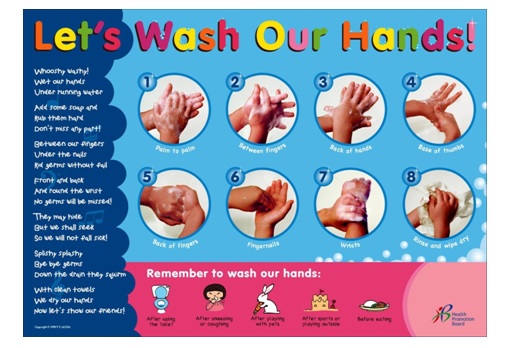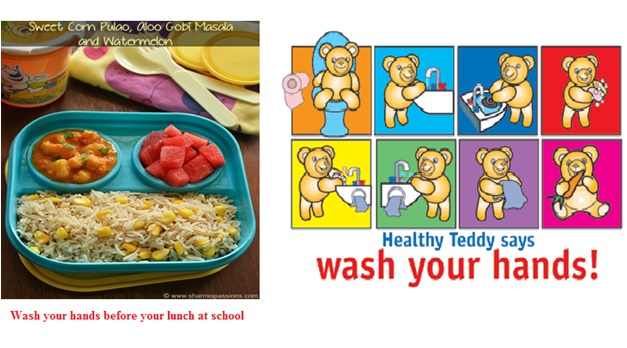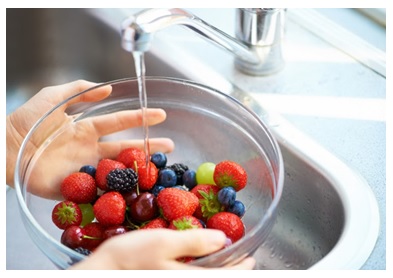SAFE PRACTICE FOR KIDS
WHY WE WASH OUR HANDS BEFORE HANDLING OUR FOOD?
BECAUSE YOU DON’T WANT TO GET SICK…..Yucky bacteria can get on to kids hands and make kids sick. That is why it is important to wash your hands with warm water and soap for at least 20 seconds before and after handling food, after using the bathroom and handling pets to prevent this yucky bacteria from spreading. So what precaution you take to avoid getting sick from the bacteria (BAC)…Fight BAC !! …but how? Below are instructions
WASH YOUR HANDS USING SOAPY WATER BEFORE HANDLING FOOD
While singing “Happy Birthday to you… ” for singing 15-20 seconds wash and rinse your hands to remove those yucky bacteria from your hands. Follow below steps to keep your hands clean before handling your food that goes to your tummy !!
- Wet your hands
- Add some soap
- Rub the soap to palm and back of hand
- Apply between fingers
- Rinse the thumbs
- Rinse the fingernails
- Rinse the wrists
- Rinse the hands and dry

When do you wash your hand?
- Wash your hands and surfaces often.
- Wash your hands with soap and warm water.
- Wash your hands:• before you make or eat a snack or meal, after playing with pets, and after using the bathroom.
- Wash your hands after playing
- Wash your hands after coming back from school
- Wash your hands before and after your breakfast, lunch and supper or dinner
- Don’t forget to wash your hands before your lunch at school.

Keep it clean :
- If you use any utensils like spoon, fork always use clean knives, forks, spoons, and plates.
- Always use a clean plate. Cooked foods should not be placed on the same plate that held raw meat, poultry, or fish. Because they may carry bacteria.
- Only put food on clean surfaces. Never put your sandwiches or snacks on a dirty table or counter.
- Put backpacks and books on the floor. Don’t put them on the kitchen table or counters.
- Put your lunch box to wash, open the lid and keep it near sink and wash your hands
How to clean and handle the vegetables and fruits?
Fruits and vegetables often carry microbes and chemicals on the surface. For example what you see as white marks on surface of grapes is chemical that is sprayed to control pest or fungus. You must wash all vegetables and fruits before consuming them. How do you do it? See below:
- Wash your hands for 20 seconds with warm water and soap before and after preparing fresh produce.
- Under your adults supervision cut away any damaged or bruised areas before preparing or eating.
- Gently rub produce while holding under plain running water. There’s no need to use soap or a produce wash.
- Wash produce BEFORE you peel it, so dirt and bacteria aren’t transferred from the knife onto the fruit or vegetable.
- Use a clean vegetable brush to scrub firm produce, such as melons and cucumbers.
- Dry produce with a clean cloth or paper towel to further reduce bacteria that may be present.
- Throw away the outermost leaves of a head of lettuce or cabbage.

KEEP YOUR FOOD COLD
- Put food back in the refrigerator after snacks and meals.
- Don’t leave foods on the counter.
- Some foods that need to stay cold include: sandwiches or salads made with meat and poultry; tuna and egg salad; milk, cheese, and yogurt; Previous day prepared rice, curry, green salad,
- opened cans of sweets, peeled or cut fruits and vegetables.
- Use an insulated lunch box or bag to keep food cold at school.
- Keep your lunch in the coolest place possible. Never leave it in direct sun.
- Add an ice pack, frozen juice box, or use a thermos to keep food cold.
- Use a cooler with ice when you pack a picnic lunch.
For parents: Teach your kids following tips to stay healthy.
How can children avoid food poisoning when preparing food after school?
When coming home after school, kids can help prevent illnesses by following these recommendations: Tell them to:
- Place books, book bags, and sporting equipment on the floor, not on eating counters or the kitchen table where germs could be transferred.
- Clean out lunch boxes and throw away perishable sandwiches or other “refrigerator type” foods, such as yogurt tubes or cheese sticks, left over from lunch.
- Wash your hands before you make or eat a snack. Hands carry lots of germs, and not washing hands is a top cause of food borne illness.
- Always use clean spoons, forks, and plates.
- Wash fruits and vegetables with running tap water before you eat them.
- Do not eat bread, cheese, or soft fruits or vegetables that are bruised or have spots of mold.
- Do not eat unbaked cookie dough because it may contain raw eggs that can have Salmonella bacteria.
- Do not leave cold items, like milk, lunchmeat, hard cooked eggs, or yogurt, out on the counter at room temperature. Put these foods back in the refrigerator as soon as you’ve fixed your snack.
- Don’t eat any perishable food left out of the refrigerator, such as pizza — even if it isn’t topped with meat. Food should not be left in the temperature “Danger Zone” of 40 to 140 °F for more than 2 hours (1 hour if the temperature is 90 °F or higher).
If you have a microwave at home teach your kids to what cautions they need to take while handling microwave. See below:
What cautions are important for school children using the microwave?
Heating or cooking foods in microwave ovens can present food safety and personal safety challenges. Some foods do not heat evenly to destroy all bacteria that could be present. Keep these tips in mind to prevent food poisoning:
- Read package directions carefully. Adults should know the wattage of the oven and tell children whether to use the minimum or maximum cooking time on food package directions.
- Use only microwave-safe cookware. Don’t put metal or foil-wrapped foods in the microwave. Never microwave food in cold storage containers, such as margarine tubs, cottage cheese cartons, or bowls from frozen whipped topping. The containers can melt and transfer harmful chemicals into the food.
- For more even cooking and to better destroy bacteria, cover a dish of food with a lid, plastic wrap, or wax paper. Turn up one corner to let excess steam escape while food is microwaving.
- Halfway through cooking, rotate food packages and dishes or stir food during microwaving — even if the oven has a turntable. This helps the food cook more evenly and safely.

